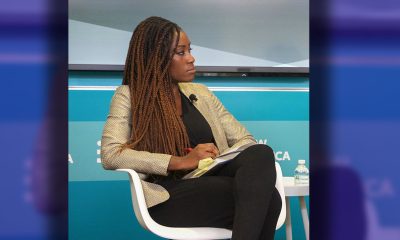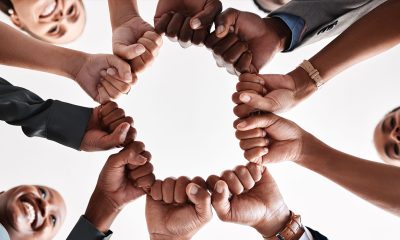Technology
Can Phone Companies Do More to Block Robocalls?

In this photo taken April 3, 2015, Jeri Vargas takes a phone call at her mother’s home in the Sherman Oaks area of Los Angeles. Jeri Vargas put her elderly mother on the Do Not Call list years ago. So why is the 88-year-old woman with Alzheimers disease still getting several recorded phone calls a day pitching her everything from vacation cruises to medical alert devices and fire extinguishers? (AP Photo/Damian Dovarganes)
ANNE FLAHERTY, Associated Press
WASHINGTON (AP) — Tired of those annoying, sometimes costly, robocalls favored by scammers?
The Federal Communications Commission is being asked to consider whether more can be done to block the automated phone calls, but the options appear to be limited.
The convergence of Internet and phone lines has made it easier to blast out hundreds of thousands of calls in a matter of minutes to see who takes the bait. The question of whether these calls can be blocked has never been more pressing than around tax season, when many pretend to come from the IRS.
The phone companies say they worry that automatic call-blocking might run afoul of laws requiring them to connect phone calls and have asked the FCC to clarify that it doesn’t. Many carriers offer call-blocking services to consumers, sometimes for a fee. But they also don’t want regulators to create any hard-and-fast rules, which they say could be difficult to implement.
Consumer groups counter that the phone companies are dragging their feet for no good reason and that, once given the green light from the FCC, could block most robocalls if they wanted.
“It is time for AT&T to provide free, effective solutions to this problem immediately, so that unwanted robocalls are stopped before they reach us,” wrote Tim Marvin with Consumers Union in a recent letter to AT&T. The group, which has organized an online petition at EndRobocalls.com, sent similar letters to Verizon and Century Link.
AT&T says it’s not as easy as it sounds. Robocallers can easily “spoof” their identity and location by pretending to be from a legitimate source or by altering the caller ID. So blocking robocalls is “a bit like a game of Whac-A-Mole: just as numbers are identified for blocking, the robocaller spoofs another number,” the company said in an FCC filing.
The U.S. passed the widely popular “Do Not Call” legislation in 2003. Commercial telemarketers are not allowed to call you if you’ve put your number in the registry unless they have “an established business relationship” with you. But unsolicited phone calls remain a top consumer complaint. The Federal Trade Commission, which goes after businesses for deceptive business practices, say it receives on average of 150,000 complaints a month on robocalls and has filed more than 100 lawsuits against violators of the Do Not Call rules.
Still, regulators and phone companies say they remain stumped on how to fix the problem for good.
“For every company we can shut down, there are probably 10 to 100 companies that can pop up in its place,” said Patty Hsue, an FTC staff attorney who leads the agency’s technical initiatives against robocalls.
A common example is “Rachel from Cardholder Services.” The automated voice recording encourages listeners to press a number, which connects them with someone who promised to lower their interest rates in exchange for an upfront fee. The FTC was able to trace the calls back to multiple people inside the U.S. and demand refund checks, but copycat scams continue.
Jeri Vargas says she put her mother on the “Do Not Call” list several years ago, but the 88-year-old woman diagnosed with Alzheimer’s disease still gets several recorded phone calls a day pitching her on everything from vacation cruises to medical alert devices and fire extinguishers.
Aggressive telemarketing calls tipped Vargas off to her mother’s failing health, she says. Yachting equipment arrived at the house one day, followed by magazines, books and light bulbs her mom didn’t need. Vargas hid her mom’s credit cards, only to find out later that a man claiming to sell fire extinguishers had her mom search through old statements to provide him a credit card number. Vargas says she thinks that robocalls were an easy way of identifying her mother as a vulnerable target. Now the phone rings all day long, but Vargas is reluctant to get rid of the line in case of an emergency.
“I don’t mind if someone calls me because I can say, ‘No thank you,'” said Vargas. “But it’s hard for someone like my mom.”
The problem has gotten so bad nationwide that the FTC in 2012 began offering cash prizes for technical solutions. Among the winners is Nomorobo, which hangs up on robocallers for you. But it only was built to work on certain phone lines, namely Voice-over-Internet Protocol, or VoIP.
Consumers groups say that the emergence of Nomorobo and other anti-robocalling technologies suggest the phone companies have the technical ability to spot obviously fraudulent calls.
Enter the National Association of Attorneys General. The group of state lawyers last fall, led by Missouri and Indiana, asked the FCC to clarify whether blocking robocalls might violate any telecommunications statutes. The major carriers say they agree that some legal guidance would be useful, but they also say they don’t want to become beholden to any new regulation. USTelecom, an industry group, said in a statement that “complex technological and legal issues” remain.
The FCC confirmed this month that it is reviewing the NAAG petition, as it’s required to do with any petition, but declined to comment further. There’s no deadline for the agency to respond.
___
Follow Anne Flaherty at http://twitter.com/AnneKFlaherty
Copyright 2015 The Associated Press. All rights reserved. This material may not be published, broadcast, rewritten or redistributed.
Alameda County
OPINION: Argent Materials Oakland CleanTech Community Asset Helps Those In Need
Alameda County Supervisor Lena Tam had this to say about Argent Materials as an Oakland community asset: “Congratulations to Argent Materials and its President and Founder, Bill Crotinger! The company is now fully operational, recycling an impressive 99.99% of concrete and asphalt debris, which helps divert thousands of tons of construction waste from landfills. They are also proud to announce that 50% of their team consists of local hires. In celebration of Thanksgiving, and despite stormy weather last week, the Alameda County Sheriffs, alongside Mr. Crotinger and Argent Materials’ dedicated staff distributed turkeys and pies as a heartfelt gesture of gratitude to the community.”

Zennie Abraham
CEO, Zennie62Media
Argent Materials, the Oakland business that turns old concrete and asphalt into new construction products, generally goes by “Argent Materials Oakland CleanTech” but should be called “Argent Materials East Oakland CleanTech for The Community”. Here’s why.
First, Argent Materials is located at 8300 Baldwin St, right in the Coliseum Industrial Zone, just a three-minute drive from the Oakland-Alameda County Coliseum Complex. That’s in East Oakland, and just a city-block walk from the Oakland Coliseum BART Station.
Second, Argent Materials has been a friend to East Oakland and what some, like the members of the Oakland Private Industry Council, would call a “community asset”. In 2024, Argent Materials founder and President Bill Crotinger was named Leader of the Year by the Oakland Private Industry Council (OPIC) “I was humbled and honored to be named Leader of the Year by the Oakland Private Industry Council. Truly an honor. My heartfelt thanks to my friend and mentor Pastor Raymond Lankford and all the wonderful people at OPIC.”
Alameda County Supervisor Lena Tam had this to say about Argent Materials as an Oakland community asset: “Congratulations to Argent Materials and its President and Founder, Bill Crotinger! The company is now fully operational, recycling an impressive 99.99% of concrete and asphalt debris, which helps divert thousands of tons of construction waste from landfills. They are also proud to announce that 50% of their team consists of local hires. In celebration of Thanksgiving, and despite stormy weather last week, the Alameda County Sheriffs, alongside Mr. Crotinger and Argent Materials’ dedicated staff distributed turkeys and pies as a heartfelt gesture of gratitude to the community.”
ABI Foundry reports that Argent Materials led a community clean up for the residents and businesses of Russett Street as well as San Leandro Street. An ABI Foundry team member said “Bill Crotinger at Argent Materials spearheaded the initiative to clean San Leandro street, from Hegenburger to 98th Ave. along the side of BART. AB&I enjoyed participating along with Acts Full Gospel C.O.G.I.C (Men of Valor), Good Hope Missionary Baptist Church-Oakland (Reverend Michael Jones) and Argent Materials. You should see how it looks now. It is AMAZING! It takes an ambitious mind to make a difference block by block.”
What Is Cleantech And Why Is It Important to Oakland And Argent Materials?
Clean technology (Clean Tech) refers to products, services, and processes that mitigate negative environmental impacts by increasing energy efficiency, promoting resource sustainability, and minimizing waste and pollution, ultimately contributing to a low-carbon, and more sustainable economy.
What is The Clean Tech of Argent Materials of Oakland?
In Argent Materials’ context, “cleantech” refers to their sustainable business model which includes recycling concrete and asphalt into new aggregate materials, diverting waste from landfills, and using renewable diesel for their fleet to achieve carbon neutrality and protect the environment. This business approach Argent Materials uses aligns with the broader definition of cleantech, which involves products, services, and processes that reduce negative environmental impacts through resource efficiency and environmental protection
Clean Tech, or green tech as Argent Materials of Oakland does it, is defined as any technology that minimizes negative environmental impact by reducing human consumption of natural resources and by promoting more sustainable and efficient resource use.
Argent Materials will continue to be a cleantech community asset to Oakland well into the future.
Stay tuned.
Activism
Golden State Warriors Program Is Inspiring Next Generation of Female Engineers
Breaking down barriers and biases that deter young girls from pursuing STEAM subjects is essential for creating a level playing field and ensuring equal opportunities for all. By challenging stereotypes and promoting a culture of inclusivity and diversity in STEAM fields, experts believe young girls can be empowered to pursue their interests and aspirations without limitations confidently. Encouraging mentorship, providing access to resources, and celebrating girls’ achievements in STEAM are all crucial steps in creating a supportive environment that fosters success.

By Y’Anad Burrell
The Golden State Warriors and e-commerce giant Rakuten are joining forces to inspire the next generation of female engineers through Building STEAM Futures, part of The City Calls campaign.
Organizers say the initiative is founded on the idea that science, technology, engineering, arts, and mathematics (STEAM) are crucial fields for innovation and progress, and empowering young girls to pursue careers in these areas is more important than ever. Studies consistently show that girls are underrepresented in STEAM fields, resulting in a gender disparity that limits potential and hinders diversity.
Breaking down barriers and biases that deter young girls from pursuing STEAM subjects is essential for creating a level playing field and ensuring equal opportunities for all. By challenging stereotypes and promoting a culture of inclusivity and diversity in STEAM fields, experts believe young girls can be empowered to pursue their interests and aspirations without limitations confidently. Encouraging mentorship, providing access to resources, and celebrating girls’ achievements in STEAM are all crucial steps in creating a supportive environment that fosters success.
On Saturday, March 8, International Women’s Day, the Warriors and Rakuten hosted 20 middle school girls from Girls Inc. of Alameda County at Chase Center’s Above the Rim for a hands-on bridge-building experience. The young girls from Girls, Inc. of Alameda County had an opportunity to design, build and test their own bridge prototypes and learn the fundamentals of bridge construction from the Engineering Alliance and the UC Berkeley Steel Bridge Team.
This STEAM experience for the girls followed the first session in January, where they took a behind-the-scenes tour of the Golden Gate Bridge, learning about its design and construction from industry experts. The City Calls campaign, tipped off with the unveiling the Warriors’ new bridge-themed City Edition jerseys and court design earlier this year.
Activism
Self-eSTEM Empowers BIPOC Women, Girls in Science, Math
In January 2025, Self-eSTEM will launch digital and generative AI programming, which provides digital literacy and AI literacy training through an entrepreneurial project-based activity. This programming will be a hybrid (i.e. in-person and online). Additionally, thanks to a grant from Comcast, in spring 2025, the organization will have a co-ed series for middle and high school students.

By Y’Anad Burrell
Special to The Post
In a world where technology plays an increasingly central role in all aspects of life, the importance of Science, Technology, Engineering, and Math (STEM) education cannot be overstated. Recognizing the significance of STEM for the future, focusing on young women and girls is a critical step in achieving gender equality and empowering the next generation.
Self-eSTEM, an Oakland-based non-profit organization, was founded by Adamaka Ajaelo, an Oakland native who had a successful corporate career with several Bay Area technology and non-tech companies. Ajaelo boldly decided to step away from these companies to give 100% of her time and talent to the non-profit organization she started in 2014 in the belief that she can change the game in innovation and future STEM leaders.
Over the course of a decade, Ajaelo has provided futurist tech programming to more than 2,000 BIPOC women and girls. The organization has an Early STEM Immersion Program for ages 7-17, Emerging Leaders Workshops for ages 18-25 and volunteer network opportunities for ages 25 and up.
In January 2025, Self-eSTEM will launch digital and generative AI programming, which provides digital literacy and AI literacy training through an entrepreneurial project-based activity. This programming will be a hybrid (i.e. in-person and online). Additionally, thanks to a grant from Comcast, in spring 2025, the organization will have a co-ed series for middle and high school students.
While the organization’s programs center on innovation and technology, participants also gain other valuable skills critical for self-development as they prepare for a workforce future. “Self-eSTEM encourages young women to expand on teamwork, communication, creativity, and problem-solving skills. The organization allows young women to enter STEM careers and pathways,” said Trinity Taylor, a seventh-year innovator.
“Our journey over the last decade is a testament to the power of community and opportunity, and I couldn’t be more excited for what the future holds as we continue to break barriers and spark dreams,” said Ajaelo.
“By encouraging girls to explore STEM fields from a young age, we foster their intellectual growth and equip them with the tools needed to thrive in a competitive global economy,” Ajaelo says.
Empowering young girls through STEM education is also a key driver of innovation and progress. When young women and girls are encouraged to pursue careers in STEM, they bring unique perspectives and problem-solving approaches to the table, leading to more diverse and inclusive solutions. This diversity is crucial for driving creativity and pushing boundaries in scientific and technological advancements.
Self-eSTEM has fundraising opportunities year-round, but year-end giving is one of the most critical times to support the program. Visit www.selfestem.org to donate to the organization, as your generosity and support will propel programming support for today’s innovators.
You will also find more details about Self-eSTEM’s programs on their website and social channels @selfestemorg
-

 Activism4 weeks ago
Activism4 weeks agoOakland Post: Week of November 19 – 25, 2025
-

 #NNPA BlackPress3 weeks ago
#NNPA BlackPress3 weeks agoLIHEAP Funds Released After Weeks of Delay as States and the District Rush to Protect Households from the Cold
-

 Alameda County3 weeks ago
Alameda County3 weeks agoSeth Curry Makes Impressive Debut with the Golden State Warriors
-

 Activism4 weeks ago
Activism4 weeks agoOakland Post: Week of November 26 – December 2, 2025
-

 #NNPA BlackPress3 weeks ago
#NNPA BlackPress3 weeks agoSeven Steps to Help Your Child Build Meaningful Connections
-

 #NNPA BlackPress4 weeks ago
#NNPA BlackPress4 weeks agoBeyoncé and Jay-Z make rare public appearance with Lewis Hamilton at Las Vegas Grand Prix
-

 #NNPA BlackPress3 weeks ago
#NNPA BlackPress3 weeks agoSeven Steps to Help Your Child Build Meaningful Connections
-

 #NNPA BlackPress3 weeks ago
#NNPA BlackPress3 weeks agoTrinidad and Tobago – Prime Minister Confirms U.S. Marines Working on Tobago Radar System






















































